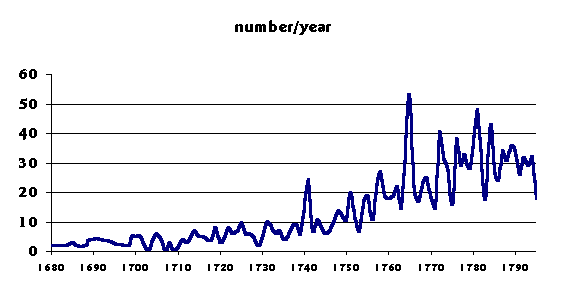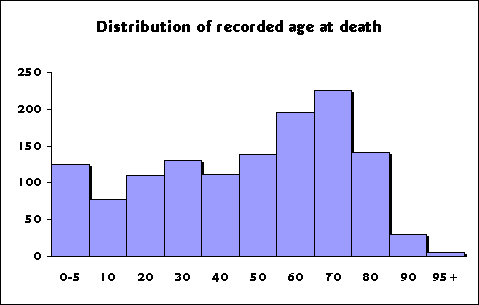 Memorials & Tombstones
Memorials & Tombstones Memorials & Tombstones
Memorials & TombstonesFeltham left a valuable list of Memorial Inscriptions dating prior to 1797 in which he covered all parishes with the unfortunate exception of Kirk Braddan. He lists approximately 1600 dated memorials - the figure shows the distribution of these by year:

The peak in 1740/41 corresponds to the years of bad harvests noted by Bishop Wilson - that of 1765 may have been a smallpox outbreak - the drop post 1795 is almost certainly an artifact as Feltham recorded them in 1797/8 and thus several may still have been in course of construction.
Many of the early memorials are inside the church and are also to members of the leading families - this bears out the comment by Browne Willis in 1722
Neither are here [ St Germans, Peel] any antient inscriptions on grave-stones, which are scarce anywhere to be met with, except some few in Kirk Malew, the governour’s parish.
This is much more likely to be accurate thanWaldron's statement about the same church -
'Tis certain that here have been very great architects in this Island; for the noble monuments in this church, which is kept in repair, and indeed in the ruins of the others also, show the builders to be masters of all the orders in that art, tho' the great number of Doric pillars prove them to be chiefly admirers of that.
Burial inside the Church was commonly desired - Bishop Wilson (1698-1755) railed against this but could not, it seems, completely prevent the custom of burial under the family's rented pew - the chancel was the property of the vicar and burials there were under his control. The famous 1795 epitaph to the grave-digger of Kingsbridge, Devon gives some of the English social aspect:
Here lie I at the chapel door,
Here lie I because I'm poor,
The farther in the more you pay,
Here lie I as warm as they.
As Waldron left a description of the graveyards: from the 1720's:
Having mentioned that there is no church-yard without a cross, I cannot forbear taking notice, that there is none which serves not also for a common to the parson's cattle; all his horses, his cows, and sheep, grazing there perpetually: so strangely is religion and rusticity mingled together in this Island !
it would appear that any memorials erected would not have stood erect for long! - however Kirk Michael still uses sheep to keep down the grass in the yard (and may have been the only such churchyard closed to visitors as a precaution during the 2001 'Foot & Mouth' outbreak!).
Waldron also left a strange description of the epitaphs:
Nor are the epitaphs and inscriptions on the tombstones less worthy of remark: the various languages in which they are engraved, testify by what a diversity of nations this little spot of earth has been possess'd. Tho' time has defaced too many of the letters to render the remainder intelligible, yet you may easily perceive fragments of the Hebrew, Greek, Latin, Arabian, Saxon, Scotch, and Irish characters; some dates yet visible declare they were written before the coming of Christ; and indeed if one considers the walls, the thickness of them, and the durableness of the stone of which they are composed
- I suspect he was confused by the Runic monuments many of which either were in, or had been removed out of superstition to, the churchyards.
In England before, and during the 17th Century, it would appear that most graves went unmarked, except possibly by small stones or simple wooden crosses with more permanent tombstones only appearing post Commonwealth (i.e. post 1660). Feltham notes a few 17th century stones with just initials, year and age(e.g. three in Lezayre). As in many things the Island lagged about a generation apart from developments in England - the statistics derived from Feltham would appear to show that tombstones started to become popular from around 1730. The expense of erecting a memorial may also have been important - in 1722/3 Daniel Quark left 30 shillings to buy two 'pool bath' [sic ? Pool Vash] stones, one for his own grave, and his brother Edmond’s grave - the 'black marble' from Pool Vaish was noted as being used for tombstones (an Edmond Quark is found in Lezayre dated 1747 but Feltham does not record one for Daniel).
The island is rich in slate, which material had been used for the 10th century Runic crosses and which weathers well - some of the earliest are tall slate posts with a simply carved 'Here lieth the body of xxx ..' usually within a a rectangular border - one early example in Onchan (John Cannell) is dated 1641 - it is however possible that these were not originally erected upright but were laid on top of the grave to prevent disturbance by animals (e.g. dogs) - their size would fit well with this function. In many cases the slab was re-used for later memorials which show the employment of professional masons. Iron Railings were used to protect individual graves and their tombstones - Feltham mentions a few in his 1798 survey though most of these and the more common Victorian railings were removed in a misguided war effort around 1940, the wrought iron recovered was unusable but much of the appearance of the yards was damaged.
The churchyard had to be walled to keep out animals - the upkeep of this wall was split between the various quarterlands who then treated the ground adjacent to their section of the wall as the burial ground for that quarterland. Sextons were not employed until late 19th century, each family arranged for the grave to be dug - it would appear that there was a common practice of reserving spaces as many yards contain small undated marker stones "X's burying place" which from their lettering would appear to date from late 18th century - in some cases a burial date was added.
By mid 18th century the 60-100 cm head stone was becoming the norm - these would be oriented east-west with the body placed below the east-facing surface (generally used for the inscription) head to the west 'to be ready to resurrect facing Jerusalem when the last trumpet sounds'. The wording on these stones was in English - a very few Latin inscriptions were noted by Feltham but these were either non-Manx or Vicars/teachers. Some Manx inscriptions have been recorded but most of these were post 1800 (and often Methodist inspired as they often quote from the Manx Hymn book)
These stones, generally of slate, had a rounded top - early 19th century examples would have a small roundel on top - within or just under this would be a small rosette of petals which design was easily marked out using a compass divider.
...TBC
Feltham's list can also give a distribution of ages at death - the following is across all parishes (except for the unrecorded Kirk Braddan).

The '10' column covers ages 6 to 15 etc.; infants are counted as < 5 years old at death. The deaths cover mostly 1720-1797 with a few earlier but weighted towards the second half century as shown in the year distribution above. It is not safe to draw any conclusions about life expectancy from these as (a) many more children are likely to have died but not have been recorded on memorials and (b) it is a biased sample as only the better off families would have raised a memorial. However the shape is skewed approximately a decade older than an, admittedly much smaller, example for Glamis of the same period quoted by Willsher.
Friends of West Hoathly Churchyard The Churchyard and Memorials [nd] West Hoathly, West Sussex RH19 4QF (excellent small pamphlet)
Frederick Burgess English Churchyard Memorials Lutterworth Press 1963 reprinted SPCK 1979
Betty Willsher Understanding Scottish Graveyards Edinburgh: Cannongate Books 1985 republished 1995(ISBN 0-86241-560-8) [contains good bibliography]
Alan Bartram Tombstone Lettering in the British Isles London: Lund Humphries 1978 (ISBN 0-85331-414-4)
|
|
||
|
Any comments, errors or omissions
gratefully received The
Editor |
||